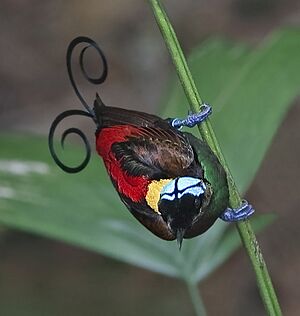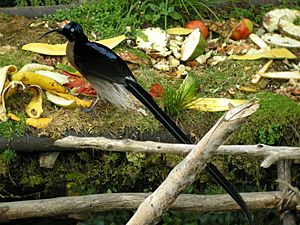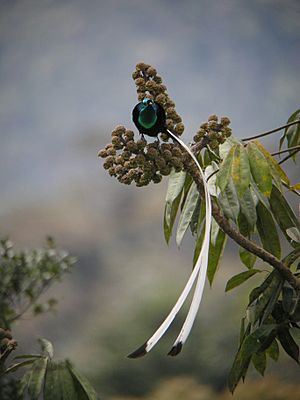Bird-of-paradise facts for kids
Quick facts for kids Birds of paradise |
|
|---|---|
 |
|
| Adult male Lesser bird-of-paradise, Paradisaea minor |
|
| Scientific classification | |
| Kingdom: | |
| Phylum: | |
| Class: | |
| Order: | |
| Suborder: | |
| Family: |
Paradisaeidae
|

The birds of paradise are amazing songbirds that belong to the family Paradisaeidae. They live in tropical places like eastern Indonesia, Maluku, Papua New Guinea, the Torres Strait Islands, and eastern Australia. Many people know the birds from the Paradisaea group, especially the greater bird-of-paradise.
These birds make their homes in warm, wet forests, including rainforests, swampy areas, and mossy forests. They build their nests from soft things like leaves, ferns, and thin vines, usually in the fork of a tree branch.
Birds of paradise are famous for the incredible feathers and special dances of the males. This is a great example of how sexual selection works, where females choose males they think are the strongest and healthiest. The male's colorful feathers, how he builds his nest, his unique song, and his special mating dance all help him attract a female. In some types of birds of paradise, a male and female stay together for life (this is called monogamous). In other types, one male might mate with several females (this is called polygamous). If they are monogamous, the male and female often look quite similar. But if they are polygamous, the males are much more colorful and flashy than the females. In both cases, the female bird always gets to choose her partner.
Sadly, hunting for their beautiful feathers and destroying their forest homes have put some bird of paradise species in danger. Today, losing their forest habitat is the biggest threat to these amazing birds.
Contents
What They Look Like

Birds of paradise are actually related to crows! They come in many sizes. The smallest is the king bird-of-paradise, which weighs about 50 grams (like a small apple) and is about 15 centimeters long. The largest is the curl-crested manucode, weighing around 430 grams and measuring 44 centimeters. The male black sicklebill has a very long tail and is the longest species at 110 centimeters. For most species, the male's tail is bigger and longer than the female's. Their wings are rounded, and some males have special wing shapes that help them make sounds.
Their bills also come in different shapes. Some are long and curved downwards, like those of the sicklebills. Others are small and thin, like the Astrapias. The size of the bill can also be different between males and females. Females often have larger bills, especially in species that eat a lot of insects.
The color of their feathers depends on their breeding habits. Females of species where males and females look very different usually have duller feathers. This helps them blend in with their surroundings and stay safe. Young males of these species also have female-like feathers. It takes a long time for them to grow their full adult colors, sometimes up to seven years! This helps protect young males from predators and also from older, stronger males.
Where They Live
Most birds of paradise live on the large island of New Guinea. Almost all types of these birds are found there. Only two groups, Lycocorax and Semioptera, live only on the Maluku Islands, which are west of New Guinea. Some riflebirds live in eastern Australia, while others live in both Australia and New Guinea. One type of manucode is found in northern Queensland, Australia. All the other species live only in New Guinea and the islands nearby. Many species live in very specific areas, like certain types of mountain forests or only on certain islands. For example, the Wilson's bird-of-paradise is found only on a few islands.
Most birds of paradise live in tropical forests, including rainforests, swamps, and mossy forests. They usually live alone in trees. Some species have even been seen in coastal mangrove forests. The species furthest south, the paradise riflebird in Australia, lives in wet forests that are a bit cooler. The manucodes are the most flexible about where they live. The glossy-mantled manucode can be found in both forests and open grassy woodlands. Many species prefer to live in mid-mountain areas, between 1000 and 2000 meters high.
How They Live
What They Eat
Birds of paradise mostly eat fruit and small insects or spiders. They might also eat a little bit of nectar (sweet liquid from flowers) and very small animals. The amount of fruit versus insects they eat depends on the species. Birds that eat a lot of fruit usually feed high up in the forest canopy (the top layer of trees). Birds that eat more insects might feed lower down. Fruit-eating birds tend to be more social, while insect-eating birds are more solitary and protect their own area.
Even birds of paradise that mostly eat insects will still eat a lot of fruit. These birds are very important for spreading seeds in the forests of New Guinea because they don't digest the seeds. Birds that eat fruit will travel far to find it. They might join other fruit-eating birds at a tree full of fruit, but they don't usually stay with them for long. They eat fruit while sitting down, not while flying. Birds of paradise can use their feet to hold and handle their food, which helps them get to the fruit inside certain tough coverings. Each species tends to eat only a few types of fruit, even though there are many choices available. For example, the trumpet manucode and crinkle-collared manucode mostly eat figs. The Lawes's parotia prefers berries, and the superb bird-of-paradise and raggiana bird-of-paradise mostly eat fruit with tough outer shells.
How They Breed
Most birds of paradise have very fancy ways of attracting a mate. The Paradisaea species use a special gathering place called a lek, where males show off to females. Other species, like the Cicinnurus and Parotia birds, perform highly detailed mating dances. In species where males and females look different, the males often mate with several females. But in species where they look similar, they are usually monogamous (one male and one female stay together).
Sometimes, different types of birds of paradise can mate and have hybrid babies. This suggests that the polygamous species are very closely related, even if they are in different groups (genera). Many hybrids have even been mistakenly described as new species in the past.
Birds of paradise build their nests from soft materials like leaves, ferns, and vine tendrils. They usually place their nests in the fork of a tree. The number of eggs in a clutch (a group of eggs laid at one time) varies. Larger species almost always lay just one egg. Smaller species might lay 2 or 3 eggs. The eggs hatch after 16 to 22 days, and the young birds leave the nest when they are between 16 and 30 days old.
Birds of Paradise and People

People in New Guinea often use the beautiful feathers of birds of paradise in their clothing and special ceremonies. In past centuries, these feathers were also very popular in Europe for decorating ladies' hats. Sadly, hunting for these feathers and destroying their homes have put some species in danger. Today, losing their forest homes due to deforestation is the biggest threat.
The birds from the Paradisaea group are the most famous, including the greater bird-of-paradise. The first Europeans learned about these birds in the early 1500s from specimens brought back by traders. These specimens had their wings and feet removed by local traders so they could be used as decorations. The European explorers didn't know this, and many strange ideas about the birds began. Some even thought they were the mythical phoenix. Because the bird skins often had no feet or wings, people believed the birds never landed but stayed in the air all the time because of their amazing feathers.
The first Europeans to see these skins were the sailors on Magellan's journey around the Earth. Antonio Pigafetta, one of the voyagers, wrote that the local people told them "those birds came from the terrestrial paradise, and they call them bolon diuata, that is to say, 'birds of God'." This is where the name "bird of paradise" comes from, and also the scientific name apoda, which means "without feet."
Images for kids
See also
 In Spanish: Paradisaeidae para niños
In Spanish: Paradisaeidae para niños



